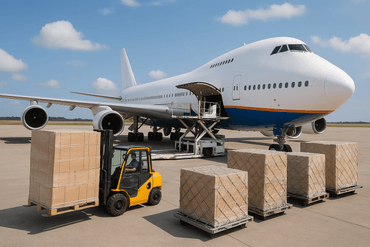
Hazardous materials transportation: 6 things to keep in mind



What are hazardous materials
It’s one thing to ship furniture such as plastic chairs and tables. They can be packaged, palletized, and loaded with relative ease. Even certain machinery, whose odd shapes and sizes would simply mean you’d require a non-standard container such as an open-top or flat rack.
But it’s a whole other ball game to ship hazardous materials that can put the health and safety of those who handle them at risk.
Hazardous materials are goods that have the potential to harm living organisms and the environment. This may be done as a standalone product/substance or via contact or reaction with other products and/or substances.
Here’s how the Federal Aviation Administration defines hazardous materials.
A dangerous good (also known as hazardous material or hazmat) is any substance or material that is capable of posing an unreasonable risk to health, safety, and property when transported in commerce.
By this definition, hazardous materials can be in solid, liquid, or gaseous form. They include everything and anything from household chemicals and lithium batteries to infectious substances, dry ice, liquid nitrogen, radioactive material, and beyond.
Naturally, shipping hazardous materials means a whole lot more preparation that includes getting the required certification, proper packaging, the appropriate paperwork, etc — all the while ensuring requirements are met and rules are complied with.
In this post, we’ll talk about how to determine whether your cargo is classified as hazardous and what to look out for when shipping hazardous material.
Is your cargo hazardous?
Determining whether your product is hazardous is trickier than it looks. Even innocuous items such as perfume, paint, and laundry detergent are considered dangerous.
To ascertain whether the product you are shipping is hazardous, refer to the material safety data sheet (MSDS) for information on the product’s physical and chemical properties. This document is obtained from the good’s supplier/manufacturer.
Hazardous goods are usually classified according to the nature of the shipping hazard the goods can potentially cause. This includes flammable material, poisonous substances, explosives, radioactive material, etc.
In the US, the Department of Transportation categorizes hazardous goods into these nine overarching categories:
- Class 1: Explosives
- Class 2: Gases
- Class 3: Flammable liquids
- Class 4: Flammable solid, spontaneously combustible, and dangerous when wet
- Class 5: Oxidizer, organic peroxide
- Class 6: Poison (toxic), poison inhalation hazard, infectious substance
- Class 7: Radioactive material
- Class 8: Corrosives
- Class 9: Miscellaneous hazardous material
Regulatory bodies of hazardous materials transportation
The transportation of hazardous goods is regulated by different bodies, depending on the mode of transportation, the country goods are being transported to/in, etc.
These are the main regulatory bodies in charge of regulating the transportation of hazardous materials.
- By air: International Air Transport Association (IATA)
- By sea: International Maritime Organization (IMO)
- By road: Country-dependent
In Europe, this is regulated by the ADR (European Agreement concerning the International Carriage of Dangerous Goods by Road).
In the US, this is regulated by the Code of Federal Regulations 49 (49 CFR) set by the US Department of Transportation (US DOT) and must comply with the Hazardous Material Regulations (HMR).
Hazardous Material Regulations (HMR)
All hazardous materials being transported within the US must comply with the Hazardous Material Regulations (HMR) issued by the USDOT.
The HMR sets out requirements for transporting hazardous goods with specific instructions on handling protocol, certifications, labeling, training, classes, definitions of hazardous goods, etc.
What to keep in mind when transporting hazardous materials
Over 1 million hazardous shipments are handled in the US on a daily basis. That presents a high chance of something going wrong.
Given the risky nature of hazardous materials, shippers and handlers must go to great lengths to ensure its safe packaging and transportation. That said, here are six things to keep in mind when shipping hazardous cargo.
1. Proper packaging
As it stands, proper packaging plays an extremely important role in the transportation of regular cargo — and more so for hazardous materials.
Dangerous cargo should be packaged securely in such a way that it poses no threat during its ocean freight journey and the turbulence it may be exposed to. It must also arrive at their destination in good condition.
When packaging hazardous cargo sensitive to changes in humidity, condensation, temperature, and moisture, make sure that the container it’s shipped in is water, wind, and airtight.
2. Label your hazardous materials as such
Because of the potential hazard that can be caused by shipping these dangerous materials, it is of utmost important to label your goods accordingly.
Ensure you use the right labels and stickers and that they’re visible on both the inner and outer packaging. Also, remove all unnecessary and unrelated labels from the outer packaging to avoid confusion.
Indicate the International Maritime Dangerous Goods (IMDG) code or United Nations (UN) number of the cargo that shows the cargo’s risk and danger level to those handling it.
You may also want to consider including the contact number of the shipper in case of emergencies.
3. Have the right documentation
Getting the paperwork ready for shipping hazardous materials is much more complicated than for regular cargo — and possibly more important.
Depending on the nature and classification of your cargo, you may require different sets of documentation in order for your cargo to be properly declared and cleared for transportation and handling. Some of these include the above-mentioned MSDS, a Dangerous Goods (DG) request, a DG packing list, etc.
Prior approval from appropriate authorities is also required.
For more information on applying for approval to ship hazardous materials in the US, consult the US DOT’s document on transporting Hazmat under the HMR.
4. Ensure you are trained and certified
Under USDOT regulations, shippers transporting hazardous materials must attend training sessions and obtain a certificate before they are allowed to ship Hazmat.
Different types of training and certificates with different validity periods may be required for different types of hazardous goods. For example, the certificate to ship dry ice is valid for two years.
When searching for training and certification courses, make sure they meet the requirements set by the USDOT.
5. Get insurance
Given the higher risks involved with shipping hazardous materials, it would be ill-advised to skimp on insurance.
Depending on whether you’re transporting hazardous cargo domestically or internationally, you may require different coverages.
Keep in mind the time needed to process the insurance request. So as soon as you are sure of your shipment type, value, and destination, get in touch with an insurance broker.
Take photos of your packaged cargo so that you can verify its condition should an insurance claim become necessary.
6. Plan your shipment early
Because of the amount of paperwork involved in shipping hazardous materials, getting the documents ready can be extremely challenging and time-consuming.
Our advice is to start planning at least four months in advance as just getting the required permits alone can take more than 120 days.
We recommend booking your hazardous shipment at least two weeks in advance. Prior approval from the operating carrier is required for the shipment for hazardous goods, which could take some time — and even longer if carriers are vessel sharing. Decreased trucking capacity means it is now also tougher to find truckers for hazmat transportation.
When booking your shipment, make sure to inform your freight forwarder of the nature of your goods.
iContainers does not accept the shipment of hazardous goods without prior consent by the shipping carrier. For more information on shipping hazardous materials with iContainers, get in touch with our sales team.
- 1. What are hazardous materials
- 2. Is your cargo hazardous?
- 3. These are the main regulatory bodies in charge of regulating the transportation of hazardous materials.Hazardous Material Regulations (HMR)
- 4. What to keep in mind when transporting hazardous materials1. Proper packaging2. Label your hazardous materials as such3. Have the right documentation4. Ensure you are trained and certified5. Get insurance6. Plan your shipment early
Related Articles


